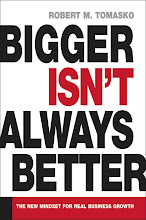January 09, 2006
The high costs of low prices
Marc Fisher’s lament (see Jan. 5 post) about a “collective sense of entitlement to low prices” applies to other companies as well as to the late Independence Air. Wal-Mart, for one, quickly comes to mind.
Last month I saw the movie WAL-MART: The High Cost of Low Price. It’s powerful and worth seeing (though it’s also a little long for something organized more by bullet points than narrative). It makes a strong case for the argument that Wal-Mart’s low-price growth strategy has significant costs as well as benefits. That’s why Business Week has called it America’s most admired and most hated company. Many of the behaviors Wal-Mart is criticized (as well as sued and fined) for are direct consequences of the scale it achieved through this strategy.
Wal-Mart’s quest for bigness is a barrier to its economic performance as well as a lightening rod for its critics. Its economic returns have slipped as it expanded outside its original small and mostly rural markets. It hasn’t figured out how to replicate the economies of scale it once enjoyed as a regional merchant. These were the days when it had ample captive customers and contiguous markets. What it has found, instead, is that some economics – especially those inherent in the store-based retail business – just don’t scale very well. (The same is true of synergy – see my December 13 post.) In other words, past a certain point, economies of scale turn into diseconomies. In retail, the most money tends to be made by those having a big share of a local market.
The research Columbia Business School finance professor Bruce Greenwald has done (Harvard Business Review readers can find a good summary in the September 2005 issue, pp. 94-104) supports these conclusions and is well worth examining. Greenwald, and his colleague Judd Kahn, also say in that article:
Growth strategies based solely on ever-lowering prices are inevitable dead ends. Eventually you run out of costs you can cut. This is what Independence Air found the hard way (and Wal-Mart’s shareholders are slowly starting to appreciate). Wal-Mart has become more of a power than a performer. It’s a business in need of substituting smart growth for unceasing expansion.
Last month I saw the movie WAL-MART: The High Cost of Low Price. It’s powerful and worth seeing (though it’s also a little long for something organized more by bullet points than narrative). It makes a strong case for the argument that Wal-Mart’s low-price growth strategy has significant costs as well as benefits. That’s why Business Week has called it America’s most admired and most hated company. Many of the behaviors Wal-Mart is criticized (as well as sued and fined) for are direct consequences of the scale it achieved through this strategy.
Wal-Mart’s quest for bigness is a barrier to its economic performance as well as a lightening rod for its critics. Its economic returns have slipped as it expanded outside its original small and mostly rural markets. It hasn’t figured out how to replicate the economies of scale it once enjoyed as a regional merchant. These were the days when it had ample captive customers and contiguous markets. What it has found, instead, is that some economics – especially those inherent in the store-based retail business – just don’t scale very well. (The same is true of synergy – see my December 13 post.) In other words, past a certain point, economies of scale turn into diseconomies. In retail, the most money tends to be made by those having a big share of a local market.
The research Columbia Business School finance professor Bruce Greenwald has done (Harvard Business Review readers can find a good summary in the September 2005 issue, pp. 94-104) supports these conclusions and is well worth examining. Greenwald, and his colleague Judd Kahn, also say in that article:
…Enormous size alone does not deliver competitive advantage. If the purchasing power that comes with size were responsible for the company’s success, then Wal-Mart’s profitability should have increased as the company grew. Yet its operating margins (earnings before interest and taxes) have not increased since hitting their high watermark in the mid-1980s…. As Wal-Mart has grown, its profit margins have suffered in comparison with those of more geographically concentrated competitors, such as Target.
Growth strategies based solely on ever-lowering prices are inevitable dead ends. Eventually you run out of costs you can cut. This is what Independence Air found the hard way (and Wal-Mart’s shareholders are slowly starting to appreciate). Wal-Mart has become more of a power than a performer. It’s a business in need of substituting smart growth for unceasing expansion.
